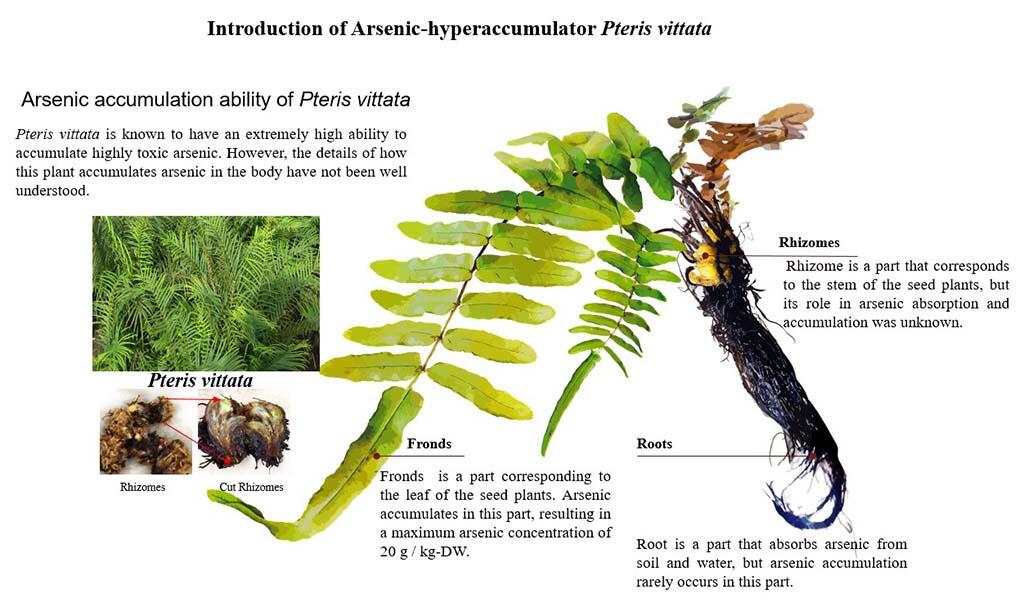A research group comprising researchers including Dr. Takeshi Koda and Professor Chihiro Inoue of Tohoku University Graduate School of Environmental Sciences, Professor Keisuke Miyauchi of Tohoku Gakuin University Faculty of Engineering, and senior researcher Nobuo Suzuki and project leader Naoki Kawachi of the Takasaki Quantum Applied Research Institute, Quantum Beam Science Division, National Institutes for Quantum and Radiological Science and Technology (QST) announced that they were successful in visualizing how Pteris vittata, a plant that can absorb and accumulate highly toxic arsenic, absorbs arsenic through the roots, transports it to the body, and still remains alive. This was achieved using arsenic-74, a positron-emitting tracer, and plant radioisotope (RI) imaging technology. At a high arsenic concentration, the rhizomes were shown to be responsible for regulating the active transport of arsenic to the mature leaves to protect the growth of young leaves. This research is expected to support the development of soil and water purification technology using plants. The results were published in the 8th issue of Scientific Reports, in July 2021.
Pteris vittata (Chinese brake) is an evergreen fern belonging to the genus Pteris, which is widely distributed in the tropical and subtropical regions worldwide, and it is indigenous to the Kyushu and Okinawa regions in Japan. It exhibits strong fecundity and grows to a height of more than 1 m. Arsenic at concentrations of approximately 10 ppm or more inhibits the growth of common plants. However, it is known that Pteris vittata can grow normally even after it accumulates 20,000 ppm (2 g per 10 kg dry weight), which is several thousand times the amount that allows for growth in other plants.
The element arsenic, with atomic number 33, is widely distributed in soils in areas that are affected by relatively recent volcanic activity, such as in Japan. Strict environmental standards are imposed because of its high biotoxicity. In Japan, the water quality environmental standard and soil environmental standard values are set to less than 0.01 mg/L. To date, Professor Inoue and his colleagues have examined the effectiveness of Pteris vittata as one of the candidates for environmental purification (phytoremediation) by plants as part of the research on the remediation of polluted soil and groundwater. To capture the movement of arsenic in Pteris vittata plants, the research group received arsenic-74 (As74), a positron-releasing radioisotope, from the short-lived RI platform and aimed to visualize the process using QST's plant RI imaging technology. Specifically, Positron Emitting Tracer Imaging System (PETIS) was used to image the process of absorption of arsenic from the roots and transport to the leaves of Pteris vittata under hydroponic conditions. The absorption and transport were also imaged under different arsenic concentrations.
As a result, the group succeeded in continuously imaging the state in which arsenic absorbed by the roots was transported to the leaves while accumulating partly in the rhizome (corresponding to the stem of angiosperms). Furthermore, the location and accumulated concentration were assessed using autoradiography and inductively coupled plasma mass spectrometry. Accumulation throughout the rhizome and young leaves and in the central vein and midshaft of mature leaves was observed when low concentrations of arsenic were administered. Conversely, when high arsenic concentrations were administered, much of it accumulated in the periphery of mature leaves, and tissue necrosis was observed.

Credit: Tohoku University, Tohoku Gakuin University, National Institutes for Quantum and Radiological Science and Technology
These analyses reveal that the rhizomes of Pteris vittata transiently accumulate arsenic absorbed from their roots and that they are responsible for the regulatory function of actively transporting arsenic to the mature leaves protecting the young leaves from damage. "Arsenic contamination is one of the major environmental issues, mainly in Asia," Professor Inoue said. "Phytoremediation is a promising approach and there are high expectations owing to its low cost. We are already conducting small-scale field experiments, but we will further investigate how to manage the surroundings and treat leaves with high arsenic concentrations. We have also found that soil microorganisms are involved in the accumulation of arsenic. We will continue to investigate this and clarify the underlying mechanisms by which this plant can survive without damage despite accumulating a high concentration of toxic arsenic."
This article has been translated by JST with permission from The Science News Ltd.(https://sci-news.co.jp/). Unauthorized reproduction of the article and photographs is prohibited.




